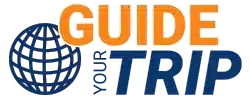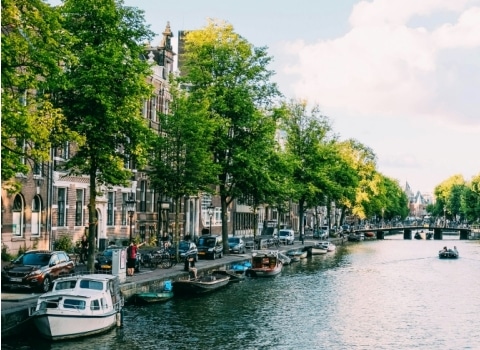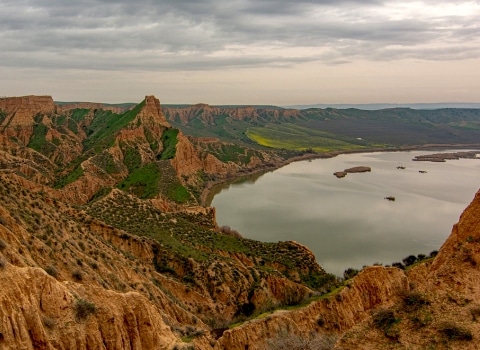Worn Steps, Hidden Patios, Unexpected Views
Lisbon, city of angles and sudden light, draws visitors in with more than just its familiar postcards—Belém Tower, the 28 tram winding up hills, the maze of Alfama humming with fado. Some of the most unusual places in Lisbon don’t appear on these postcards at all.
There’s another Lisbon. One less polished, quieter. It hides behind graffiti-covered doors, at the top of staircases most people pass without noticing. A Lisbon of chipped tiles and clotheslines and cafés where no one speaks English. A version of the city that doesn’t try too hard, and maybe for that reason, stays with you longer.
Those looking for the unexpected, not the spectacular but the unusual, might find it here. Away from the crowds, scattered across the hills, these places whisper rather than shout. And yes, it takes a bit of wandering. Some stairs. Maybe a wrong turn. But it’s worth it.
Below are 9 places in Lisbon that won’t be on every guidebook page. But they’re the kind that leave a mark.
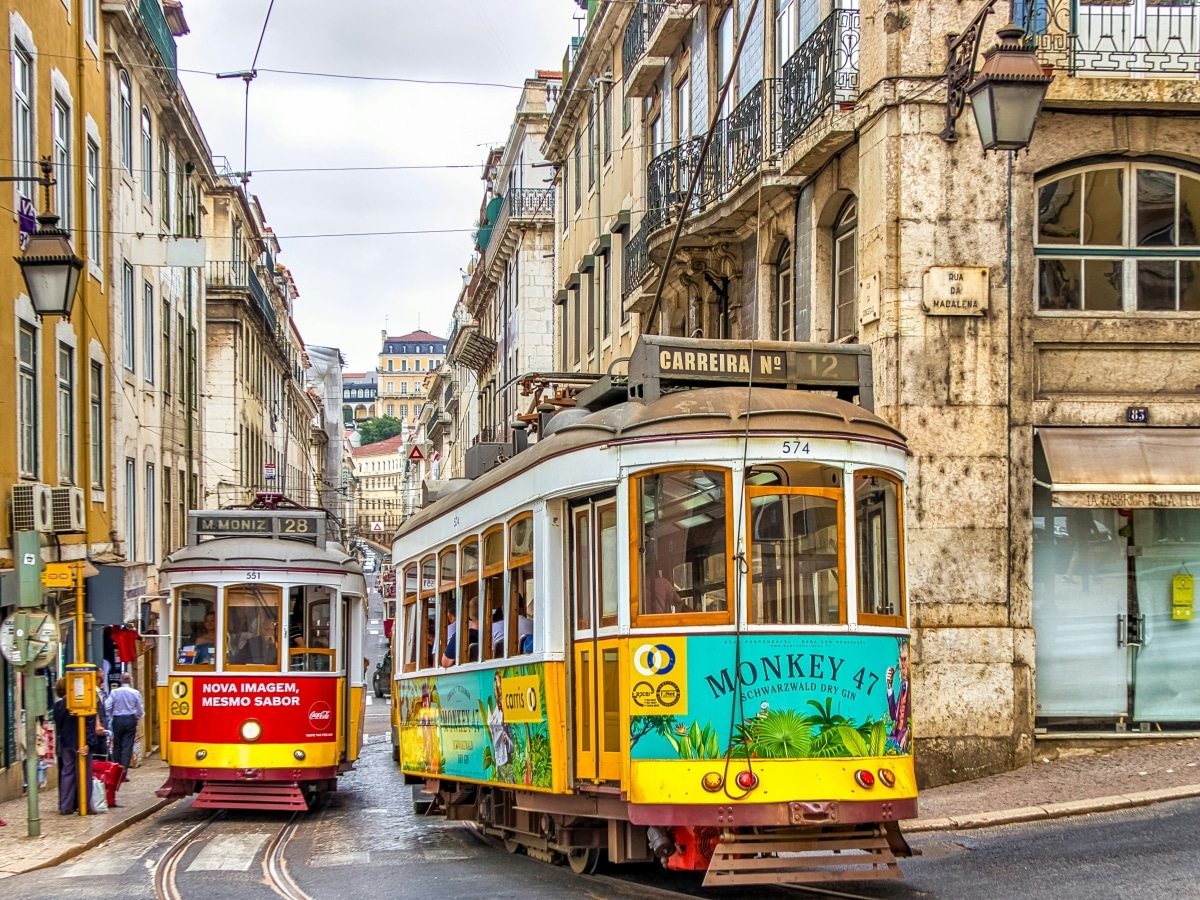
1- LX Factory: A trendy place for designers
Set in the Alcântara district, LX Factory used to be just another industrial complex—warehouses, chimneys, steel bones. Then something changed. Today, the space breathes a different life. Art galleries, small design studios, bookshops with ideas stacked to the ceiling, and cafés where the coffee smells like ambition. It’s messy in the best way. Not curated, just alive.
Street art clings to the walls like memories left behind. Colors don’t match, and that’s the point. Walk through on a Sunday, and it shifts again: market stalls fill the alleys, local makers lay out jewelry, notebooks, jars of jam, and things you didn’t know you needed until you see them. That chocolate cake from Landeau? Yes, it lives up to the rumors.
A place steeped in history, reinvented for modernity
The bones of the place haven’t moved. Red brick, heavy beams, tall windows still frame the sky. This raw skeleton—untouched in many places—now holds something looser, more inventive. Design studios where machines once groaned. Fashion boutiques that don’t feel like shops. Bookstores where time slows down.
Every turn offers a new mural or a half-finished sketch. Some walls change weekly, others stay. There’s a kind of rhythm in the visual noise. Photographers often stop here—not because it’s perfect, but because it’s unpredictable.
Shops and galleries for discovery lovers
It’s not a place for shopping in the classic sense. More like rummaging through someone’s creative mind. Clothes stitched by hand, furniture shaped from imagination rather than catalogs, jewelry with small flaws that make it better. It’s local, often personal, and rarely repeated.
One stop that pulls people in is Ler Devagar. A bookshop, yes, but something else too. Housed in a former printing press, it’s quiet, filled with the hush of pages turning. The shelves stretch toward the ceiling. Mechanical remnants hang in the air like ghosts. It’s not dramatic. Just quietly impressive.
Sundays: An even more vibrant atmosphere
Weekdays are for wandering. Sundays are louder. The market spills out with secondhand clothes, zines, jars of things, or handmade ceramics. Music floats between the stalls, sometimes played live. It’s not organized, not polished. Which is why it works. You feel like you’re in on something, even if you’re just passing through.
Practical tips for enjoying LX Factory
- When to go?
LX Factory is open daily, but Sundays bring a different energy with the open-air market. After sunset, the lights come on, the bars fill up, and the vibe shifts—more vibrant, a little louder, a little looser. - How to get there?
Trams or buses from central Lisbon will get you to Alcântara easily. On foot, it’s a long but scenic stroll from Belém or Cais do Sodré along the Tagus. Not the quickest way—but maybe the nicest. - Tip for foodies: Late afternoon visits pair well with a table at Rio Maravilha. The rooftop view of the city? Worth lingering for.
2- Casa do Alentejo: A Moorish architectural gem
Right in the middle of Lisbon, just behind Praça dos Restauradores, sits something quietly unexpected: Casa do Alentejo. From the outside, you’d never guess. The entrance is discreet, nearly hidden. But step inside, and the entire mood shifts. Tiles, arches, soft light—this former palace isn’t just another historical site. It feels like stepping into another country altogether.
The architecture borrows heavily from Moorish design—frescoes, ornate ceilings, horseshoe arches. There’s a stillness in the courtyard that’s hard to describe. Maybe it’s the fountain. Or the sense of something preserved rather than restored.
A masterpiece of architecture steeped in history
Once a palace, now a cultural center, the Casa welcomes anyone curious enough to walk through its doors. Azulejos line the walls—blue and white depictions of Alentejo countryside scenes. Not grand, but quietly detailed. The central patio, with its mosaic floor and delicate balconies, might be the most photogenic corner in all of Lisbon. Yet it rarely feels crowded.
The combination of Portuguese and Moorish styles here doesn’t scream for attention. It murmurs, softly but insistently. Look closer, and the stories start to surface.
A culinary journey at the first-floor restaurant
Upstairs, a restaurant serves dishes from the Alentejo region—comforting, robust food that doesn’t try to impress, just satisfies. Açorda, pork with clams, cured cheese—nothing complicated. But it lingers. Even the setting feels like a throwback: high ceilings, painted walls, chandeliers that feel just a bit too grand for lunch. Which is exactly why it works.
You don’t have to eat to enjoy the place. The rooms alone—quiet, museum-like—offer enough. They whisper of a time when detail mattered more than efficiency.
A cultural immersion into Alentejo
Beyond food and architecture, Casa do Alentejo hosts concerts, exhibitions, and craft displays—all tied to the region it represents. It’s not flashy. But that’s the point. It invites you to slow down, stay a while, pay attention.
Tip: There’s no entrance fee. Just walk in. Best to come before the lunch rush or late in the afternoon, when it’s quiet and you can linger without feeling in the way.
How to get there?
The entrance is easy to miss—just steps from the Restauradores metro station. Look closely, and you’ll find it. Inside, everything opens up.
3- Madragoa and Graça districts: Authenticity and calm
When Lisbon starts to feel too curated, too crowded, too much—there’s always Madragoa and Graça. Two neighborhoods that haven’t been polished for tourists. Places where the laundry still flaps from windows and the streets don’t try to impress anyone. That’s what makes them worth exploring.
With cobblestones underfoot, painted tiles on every other house, and the kind of silence that still feels inhabited, both areas offer something more personal. It’s not silence exactly. It’s Lisbon, slowed down.
If curiosity leads the way, reaching out to Lisbon tour guides can add unexpected layers—stories you might not catch on your own.

Madragoa: The quiet charm of an old fishing village
Madragoa used to be home to fishermen. Some say you can still feel it in the rhythm of the streets. The place keeps to itself. Narrow alleys, buildings chipped by time, neighbors chatting across balconies. It’s not staged. It just is.
What makes Madragoa unique:
- A village-like ambiance: No rush. People move slowly. Children play in the street, and conversations float from open windows. Compared to Baixa or Alfama, it’s practically meditative.
- Local gastronomy: The food? Honest. Small places serve bacalhau à brás or grilled sardines. No menus in five languages. Just handwritten boards and familiar smells.
- Discreet yet fascinating heritage: Convents-turned-museums, like the Museu das Artes Decorativas, blend into the neighborhood. You might pass one without noticing—until you do.
Graça : Lisbon's soul rooted in the hills
Graça rises high above the city. From up there, everything slows down again. Except the wind. Views stretch out like promises—from castle rooftops to the distant river. But Graça isn’t just about panoramas. It holds onto something older, something unspoken.
What makes Graça a must-visit:
- Spectacular miradouros (viewpoints):
- Miradouro da Graça feels like a secret picnic spot. Shade, space, a bench. And the whole city laid out below.
- Miradouro da Senhora do Monte is quieter. Fewer people. Better light. Maybe the best place to watch the day end.
- Rich historical heritage: The São Vicente de Fora Monastery doesn’t beg for attention. But once inside, it speaks loudly. Cloisters, tiled stories, rooftops that open up the whole city. Worth the climb.
- A local atmosphere: This is still a lived-in place. Markets open early. Cafés pour bica for the same faces every morning. No rush. Just daily life, still intact.
4- Puppet Museum
In the quieter streets of Santos, tucked into an old convent, the Museum of Puppetry offers something a little out of the ordinary. It’s not loud, not flashy—just quietly captivating. For families, curious travelers, or anyone with a soft spot for craft and character, this museum tells a global story through small, expressive figures.
A journey through the world and history of puppetry
The collection moves across continents—shadow puppets from Southeast Asia, delicate Thai carvings, ornate marionettes straight out of Italy’s Commedia dell’Arte, and Portuguese figures with roots in old folktales and political satire. Each puppet has something to say. Not always loud or clear, but with detail and intention.
There’s variety here—string puppets, glove puppets, silhouettes, even a few mechanical oddities that seem to come to life if you stare long enough. It’s less about spectacle, more about presence. And the craftsmanship, once you start noticing it, is hard to ignore.
An interactive experience for all ages
This isn’t a museum that keeps you behind the rope. Some of the puppets can be handled, encouraging kids—and not just kids—to try, play, experiment. Suddenly, strings move. Mouths open. Something shifts. And the art becomes tactile, real.
Workshops pop up often. In a back room, visitors are shown how to shape a puppet, paint it, string it together. There’s glue. Mistakes. Laughter. And by the end, a small creation that moves under your control—slightly awkward, wonderfully personal.
Architecture that enhances the charm of the place
The building itself lends something special. Thick stone walls, arches, vaulted ceilings. It feels like stepping into a quiet stage set. Rooms open into each other like acts in a play. The lighting’s soft, a little theatrical. And somehow, it works—the marionettes don’t just sit behind glass. They perform, in their own way, even at rest.
Practical tip
If you’re nearby, take time to explore the Santos district. It moves at a different pace. Quiet cafés, narrow lanes, and a riverfront not far off. Perfect for a slow afternoon. Perfect, too, for letting the museum linger in your mind a little longer.
5- Tapada das Necessidades : A green oasis
Just behind the Palace of Necessidades, a stretch of green hides in plain sight. Tapada das Necessidades doesn’t announce itself. But for those who stumble in—or seek it out—it’s a kind of quiet antidote to Lisbon’s buzz.
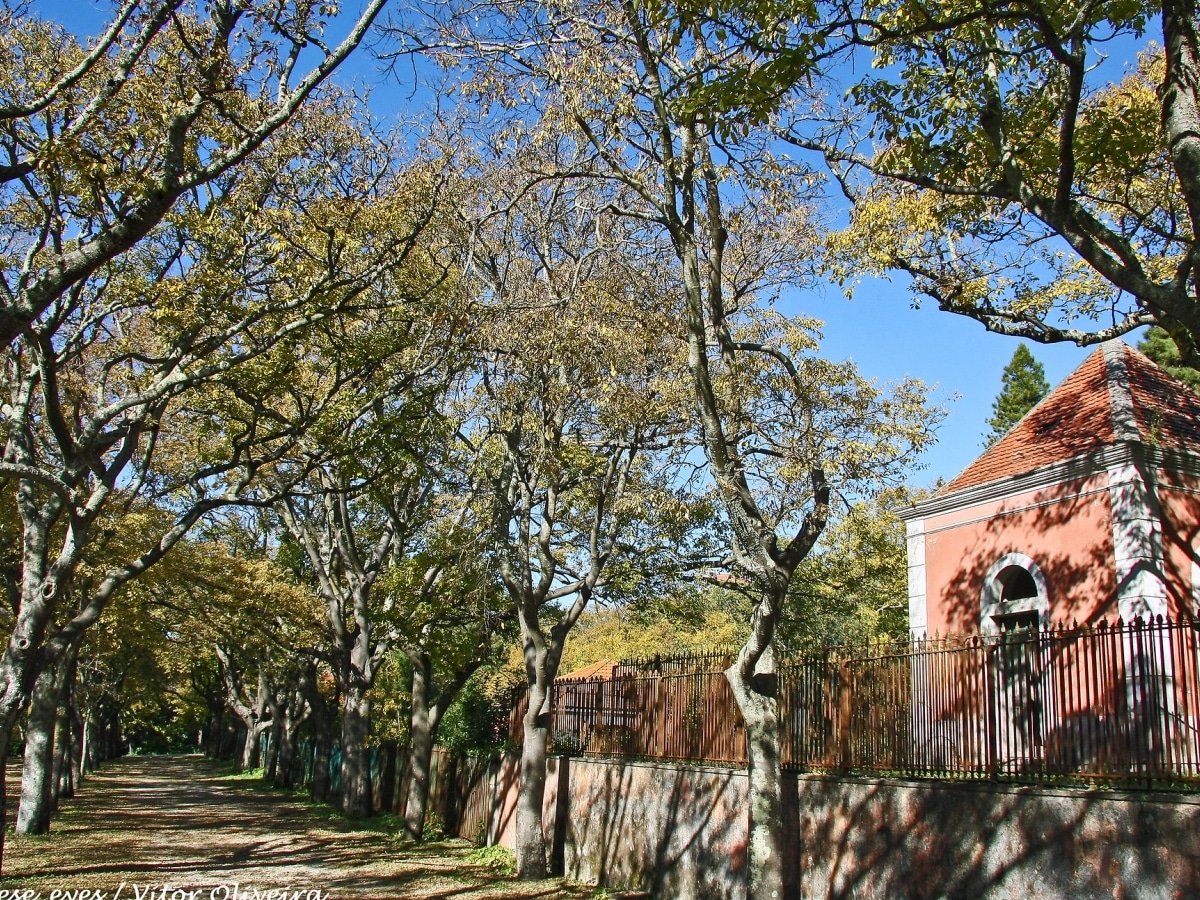
An ancient royal garden steeped in history
Commissioned in the 1700s by King John V, the garden once held a royal botanical collection. That legacy clings to the place. Trees with stories in their trunks, ponds reflecting more than just the sky, greenhouses built to protect exotic plants that no longer need them. It feels lived-in, a little overgrown, charmingly imperfect.
An ideal setting for relaxation and contemplation
It’s not landscaped to impress. Which might be why it works. The trails curve gently, sometimes vanishing under roots and leaves. There’s space to spread out, nap in the grass, read a book, or simply do nothing. The pond—home to ducks and circled by reeds—anchors the calm. Birds pass by. Time slows.
If you’re into plants, peek into the old greenhouses. They’re not always open. But even closed, they tell their own story—of a Lisbon curious about the world, wanting to grow things from other lands.
A peaceful and hidden gem
Even in summer, the park rarely feels full. Tourists often miss it, which makes it all the more inviting. And yet it’s not far from the center. Just enough of a detour to matter. The lawns open wide in places, revealing unexpected angles of the city, rooftops in the distance, light filtering through branches. A place to breathe.
How to get there?
The Tapada das Necessidades is in Santos—reachable by tram, bus, or a slow walk from the center. It’s free. Always open. Bring snacks. Or don’t. Just let the quiet do its work.
6- Jardim do Torel: A hidden view of Lisbon
It’s easy to miss. A few turns off the main streets, then up a hill—maybe with the help of the old Lavra funicular. That’s where Jardim do Torel waits. It doesn’t draw crowds. Which is part of the point.
This small garden sits high above the city. From the benches, Lisbon stretches out gently below: Baixa’s rooftops, distant spires, and light bouncing off windows. It’s a place to pause. And stay. Just long enough to feel still again.
No itinerary here. Just shade, quiet, a few regulars, and that slightly unreal feeling of finding a corner no one told you about. Sometimes a piano plays softly from somewhere nearby. Sometimes nothing happens at all. Which might be perfect.
In the warmer months, the garden reveals a surprise: a municipal pool tucked into the terrace. Not grand, but refreshing. A chance to float while the city hums below.
There’s a café too. Small. Easy to miss. But if you find it, the pastéis de nata taste better with that view. Especially at sunset, when the light gets golden and the buildings blush in response.
How to get there?
The Lavra funicular is the easiest route—an experience in itself. Or climb on foot from Avenida, following narrow streets and crooked stairs. The reward? A place that feels yours for a while.
7- Convento do Carmo: A ruin full of history
High above Chiado, where the past clings to every wall, Convento do Carmo stands exposed to the sky. What’s left of the church—columns, arches, open air—is both broken and beautiful. A quiet reminder of what Lisbon endured and what it became.
Built in the 1300s, the monastery once dominated the skyline. Then came the quake in 1755. The roof collapsed. The rest didn’t. And instead of rebuilding, the ruins were left. Not out of neglect, but reverence. Today, they frame the clouds.
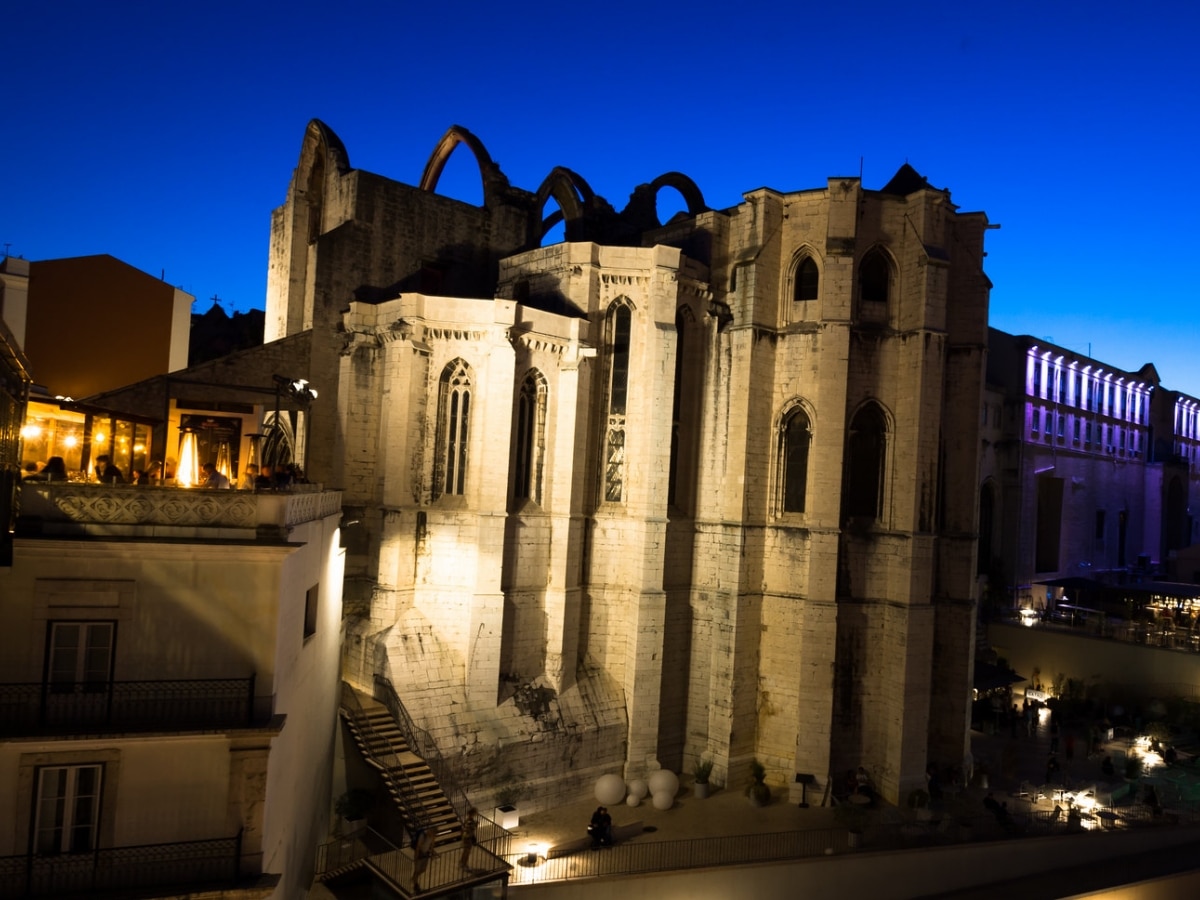
A Fascinating Architecture
There’s no ceiling now. Just arches reaching upward like ribs. Stone walls wear their scars proudly—carvings, cracks, and the patina of centuries. It’s not intact. But it’s whole in a different way. Walking through, the silence feels full.
A Museum Rich in History
Off to the side, a small museum holds an eclectic mix: ancient sarcophagi, weathered tiles, ceramics, even two Incan mummies that somehow ended up here. The collection doesn’t try to impress. But it surprises. Each piece—quiet, strange—feels like it belongs.
A Contemplative Visit
More than most monuments, this one invites stillness. Light filters through the arches. Shadows drift across the stone. There’s no guided path. Just space to reflect. Time settles differently here.
Practical Tip
Afterward, wander through Chiado. It’s a district full of old cafés, like A Brasileira, and bookstores with dust in the corners. Stay for an hour, or three. If you’re chasing light, come late in the day—the ruins glow against the sky, and every photograph feels like it’s been waiting for you.
8- A Tabacaria: A different kind of bookshop
Perched in the picturesque Alfama district, A Tabacaria is much more than just a bookstore: it’s a cultural gem where literature, design, and art blend harmoniously. This unique space occupies a former tobacco shop, hence its name, and retains a nostalgic charm that attracts both locals and curious visitors.
A place full of character
The walls of the bookstore are lined with wooden shelves brimming with carefully curated books, ranging from Portuguese classics to contemporary international works. You’ll also find rare editions, art books, and a dedicated poetry section—a genre deeply cherished in Portuguese culture.
A showcase of local craftsmanship
In addition to books, A Tabacaria features artworks and handcrafted creations by local artists. Here, you can discover handmade notebooks, original posters, and other unique treasures that highlight the rich talent of Portuguese artisans.
An ambiance that invites lingering
The atmosphere is calm and intimate, making it the perfect place to browse through a book or simply admire the displayed artworks. A cozy reading corner, complete with comfortable armchairs, invites you to take a moment to unwind and soak in the charm of this exceptional venue.
9- Águas Livres Aqueduct: An architectural highlight
Rising above the Alcântara Valley like a quiet line of stone against the sky, the Águas Livres Aqueduct often slips under the radar. Most eyes go elsewhere—toward the monuments that advertise themselves. But this structure, nearly three centuries old, holds something else. Less show. More weight.
Built in the 18th century, it was never just about beauty. Its purpose was urgent—bring clean water into a fast-growing Lisbon. What emerged, though, is more than function. A stretch of arches so tall they seem out of place. And yet, they fit. As if the valley had been waiting for them.
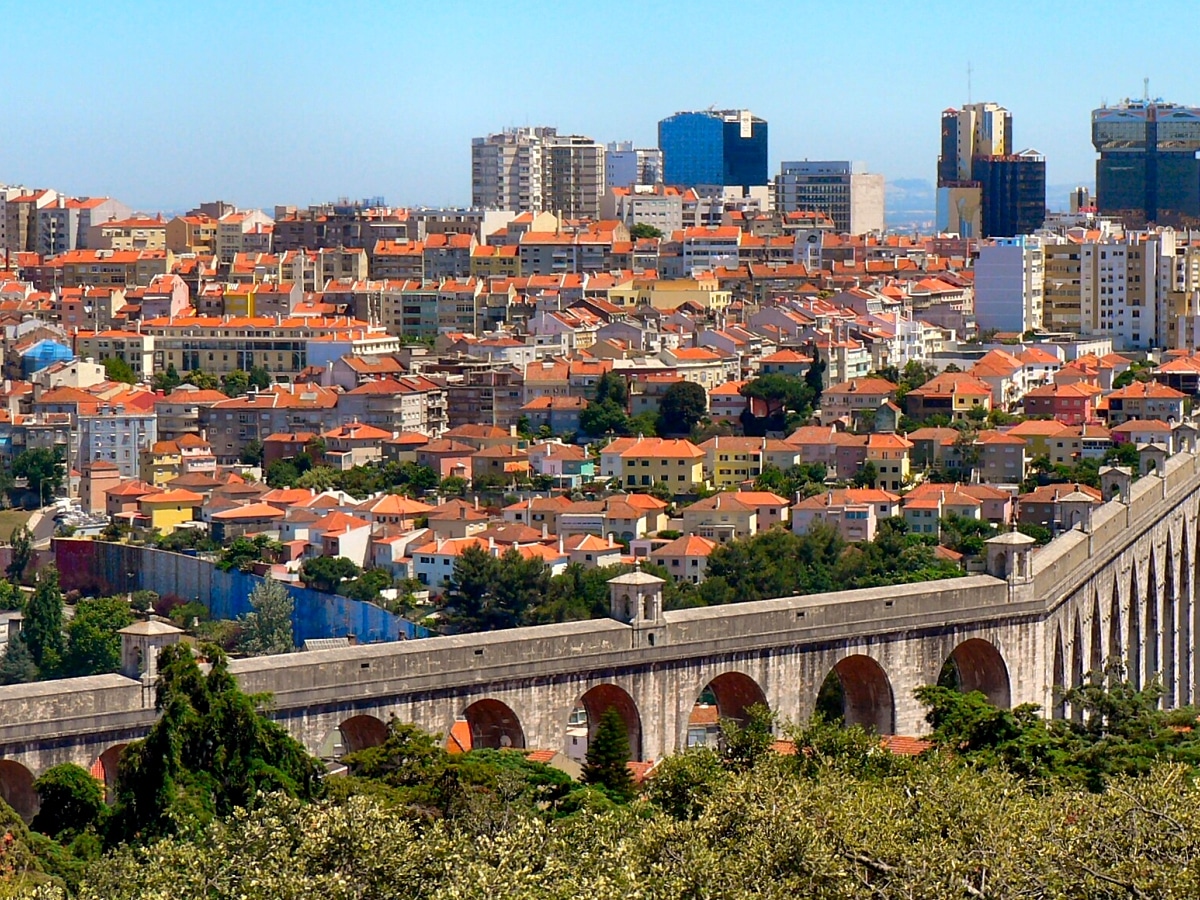
Manuel da Maia designed it. King John V backed it. In 1748, the aqueduct opened, and Lisbon could breathe a little easier. Almost 18 kilometers of stone and precision, with arches that climb over 60 meters into the air. That height still startles, even now. It was called a marvel back then—and somehow, that still holds.
Not just the scale. The endurance. The 1755 earthquake ripped the city apart—but the aqueduct stayed standing. Its resilience became legend. Pride in stone. A reminder that infrastructure, too, can carry soul.
A Journey Through History and Architecture
Visitors can walk it. Not the whole thing, just the main stretch—enough to feel the scale beneath your feet. The view: open, unexpected. Hills on all sides. Rooftops. Movement in the distance, but up here, it’s still. Lisbon looks different from this angle. Smaller. Calmer.
Stories cling to the place. Diogo Alves, the so-called aqueduct killer, is one of them. Legend says he pushed victims off the edge. Truth? Hard to say. But there’s something about the silence here that lets old stories breathe.
A Connection to the Water Museum
The aqueduct belongs to a wider story. It’s part of the Lisbon Water Museum, where pipes, pumps, and preserved machines tell how the city learned to live with thirst. Not just facts and figures—fragments of daily life, things once taken for granted now resting behind glass.
Paired with the walk across the aqueduct, the museum adds context. Not essential, maybe. But if you’re curious about how cities really work, how they stay alive—worth the time.
Practical Tips
- Opening Hours: Usually open on weekdays, sometimes weekends too. Check online—times shift with the season, and access isn’t always guaranteed.
- How to Get There: Head to Campolide station. A bus will also do. The entrance is quiet, easy to miss. Just a simple door near the edge of the district. Keep your eyes open.
- Duration of Visit: An hour is plenty. A little more if you want to linger. And you might. The light changes fast up there.
